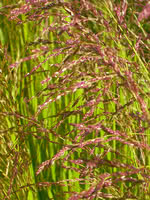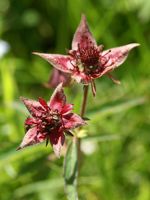Mon-Fri 9am - 5pm Mountain time
Tall Manna Grass vs Marsh Cinquefoil
Glyceria grandis
Comarum palustre
CUSTOM GROW
CUSTOM GROW
Manna Grass and other waterside plants are an excellent way to prevent erosion and provide habitat and forage for animals. The difference is that Manna Grass looks better doing it! With distinctive purple grains at the top of its stalks, Manna Grass adds a splash of color to the waterside that most other aquatics can't offer.
Manna Grass is good for returning disturbed sites to nature and provides nourishment to many animals, except for cattle who find it toxic.
Marsh Cinquefoil is a native perennial wetland plant with striking reddish-purple, star-shaped flowers. They bloom in early to mid-summer, providing nectar for bees, flies, and other pollinators. Beyond its summer blooms, the foliage turns red in autumn, adding seasonal interest to wetland landscapes.
Common in wetlands, pond margins, and wet meadows, Marsh Cinquefoil spreads by rhizomes to form colonies or patches that contribute to shoreline stabilization. It thrives in nutrient-poor, saturated soils where many other plants struggle, making it valuable in challenging wetland conditions. With its ecological function and ornamental appeal, it is well-suited for wetland plantings, ecological restoration, and naturalized projects.
Tall Manna Grass Quick Facts
Marsh Cinquefoil Quick Facts
Toxicity: toxic to cattle

